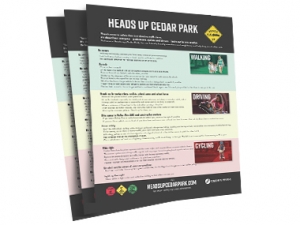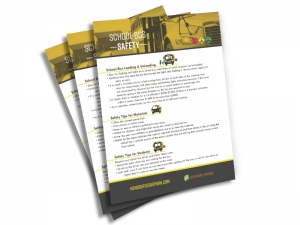Safety Tips
Click here for a downloadable, printable safety tips flyer to share with your family members, friends, neighbors and students to help them remember to have a Heads Up when walking, cycling or driving.
Click here for a downloadable, printable school bus safety tips flyer to share with your family members, friends, neighbors and students to help them remember to have a Heads Up when they see a school bus.
Click here for a downloadable, printable Halloween safety flyer to share with your family members, friends and neighbors to help them remember to have a Heads Up when trick-or-treating.
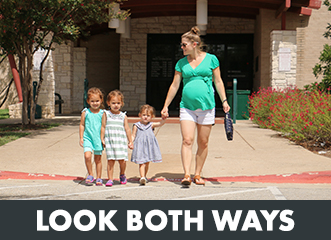
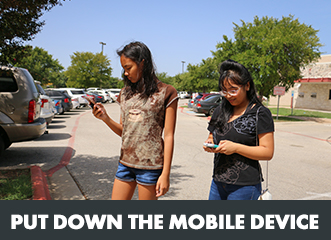
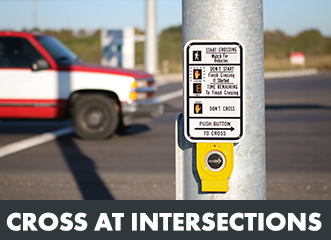
Walking Safely
Tip #1
Put down that mobile device
It’s not possible to be fully alert to your surroundings if you are walking and texting. Wait until you are stopped and in a safe place to use your device.
Tip #2
Stop, look and listen
Look both ways before crossing a street and watch and listen for vehicles.
Tip #3
Cross only at intersections – particularly one with a marked crosswalk
Drivers and cyclists should have a heads-up for pedestrians and cyclists in a crosswalk.
Tip #4
Make eye contact with drivers before crossing driveways and streets
Be sure that the driver also sees you before crossing.
Tip #5
Cross in front of, not behind, vehicles when possible
Pay particular attention for vehicles backing out of driveways and do not cross between parked vehicles or vehicles waiting at an intersection, as drivers may not see you.
Tip #6
At intersections with pedestrian signals, cross only on the walk signal
Walk or diagram of person walking means to begin crossing the intersection. Be sure to look both ways before entering the roadway.
A flashing “don’t walk” or hand means do not enter the intersection but finish crossing if you’ve already started.
Don’t walk or a hand in read means do not enter the roadway. Wait until the next walk signal.
Tip #7
Stay out of blind spots of buses and large vehicles
The ten feet surrounding a bus or large vehicle is considered the danger zone because it’s nearly impossible for the driver to see you.
Avoid the danger zone and never cross directly in front of the bus or large vehicle.
Wait for the bus or large vehicle to leave, then cross in a designated crosswalk if possible.
Tip #8
Glow in the dark
Do not wear dark clothing when walking in the dark. Wear white or light colors and reflective clothing so that others can see you.
Cycling Safely
Tip #1
Follow the rules of the road
Under State law cyclists operate with the same rights and responsibilities as motor vehicle drivers. This means you must obey traffic signals and stop signs.
Tip #2
Learn cycling hand signals and use them
Hand signals help you communicate with others that you’re turning or changing lanes.
Tip #3
Be alert and be aware of your surroundings
It helps you predict the actions of others – such as turning or a door opening – and avoid a collision.
Tip #4
Ride to the right when possible
On roads with designated multiuse or bicycle lanes, use them.
While you do have the right to ride in the center of most road lanes, make sure that other drivers see you.
Tip #5
Ride in the same direction as traffic
Bicycles operate as vehicles and are required to travel in the same direction as other drivers.
Never ride facing oncoming traffic. It’s one of the leading causes of bicycle-motorized vehicle crashes.
Tip #6
Claim your space at intersections
Position yourself at intersections in a way that ensures you are seen by others.
When approaching an intersection, use the rightmost lane going in the direction of your destination. When making a left turn with multiple turn lanes, select the rightmost left turn lane.
Tip #7
Light up the night
Do not wear dark clothing when cycling at night. Wear white or light colors and reflective clothing so that others can see you.
State law requires a front headlight and rear reflector or rear red light to be used when cycling at night.
Tip #8
Don’t text and ride
You may be a great multi-tasker, but it’s illegal and dangerous to text while cycling. Wait until you reach your destination to use your mobile device so that you can stay alert to your surroundings.
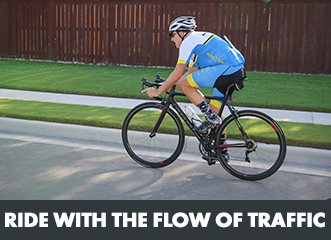


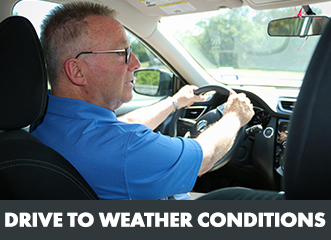
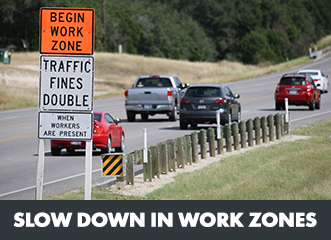
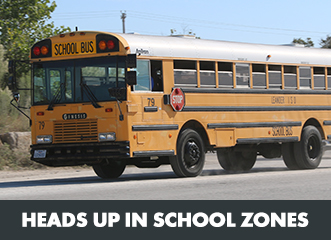
Driving Safely
Tip #1
Heads up for school zones and school buses
Maintain the posted school zone speed limit.
Pay attention! Be aware of children’s unpredictable movements in these zones.
Flashing yellow lights on a school bus mean that it’s getting ready to stop. Flashing red lights on a school bus and a stop sign extended from the side means that the bus is stopped and is loading or unloading children. You are required to stop as long as the bus’s red lights are flashing and its stop sign is extended, to allow for the safe passage of children. Also watch for child pedestrians – regardless of whether the bus has started or finished unloading.
Tip #2
Heads up for pedestrians
Pedestrians are everywhere.
Be on the lookout especially for child pedestrians, who may not always remember safety rules.
When approaching an intersection, slow down and scan the road and sides of the road ahead for pedestrians.
Always yield to pedestrians in crosswalks and never block or park in a crosswalk.
Tip #3
Heads up for cyclists
Allow a minimum of three feet to the side when passing a cyclist.
Look out for cyclists when opening your door while parallel parked.
Do not drive or park in designated bicycle or multiuse lanes.
Treat bicycles as motor vehicles. They have the right to ride in the center of most road lanes.
Tip #4
Give space to Police, first responders and construction workers
If you see a Police, Fire or Ambulances behind you, move to the right if possible. And if you see them pulled over in front of you slow down and move over at least one lane to ensure their safety.
Slow down in construction zones. There are people working out there. They’re all working for you!
Tip #5
Focus on the task at hand: driving
Texting while driving is illegal because it’s extremely dangerous. Make a personal pledge not to use your mobile device while driving.
Eating, reading, putting on makeup and having a lively conversation are all examples of distracted driving.
Whatever it is, save it until you reach your destination.
Tip #6
Slow down and drive to conditions
Remember: it’s a speed limit, not a speed minimum. Just because the posted speed limit is 45 miles per hour, for example, does not necessarily mean that you should go 45 miles per hour. If it’s raining, icy or there is heavy traffic for some reason, slow down and pay close attention.
Tip #7
Flashing yellow signals mean yield
Whether it’s a flashing yellow arrow at a turn signal or at a signal in front of a fire station, it means to yield for other traffic, then proceed through the intersection if it’s clear.
Tip #8
The left lane is for passing
On a multi-lane road such as a highway, slower-moving traffic should keep to the right.
The left lane is reserved for faster-moving traffic to pass. And if you use the left lane to pass, move back to the right after you’ve made your move.

